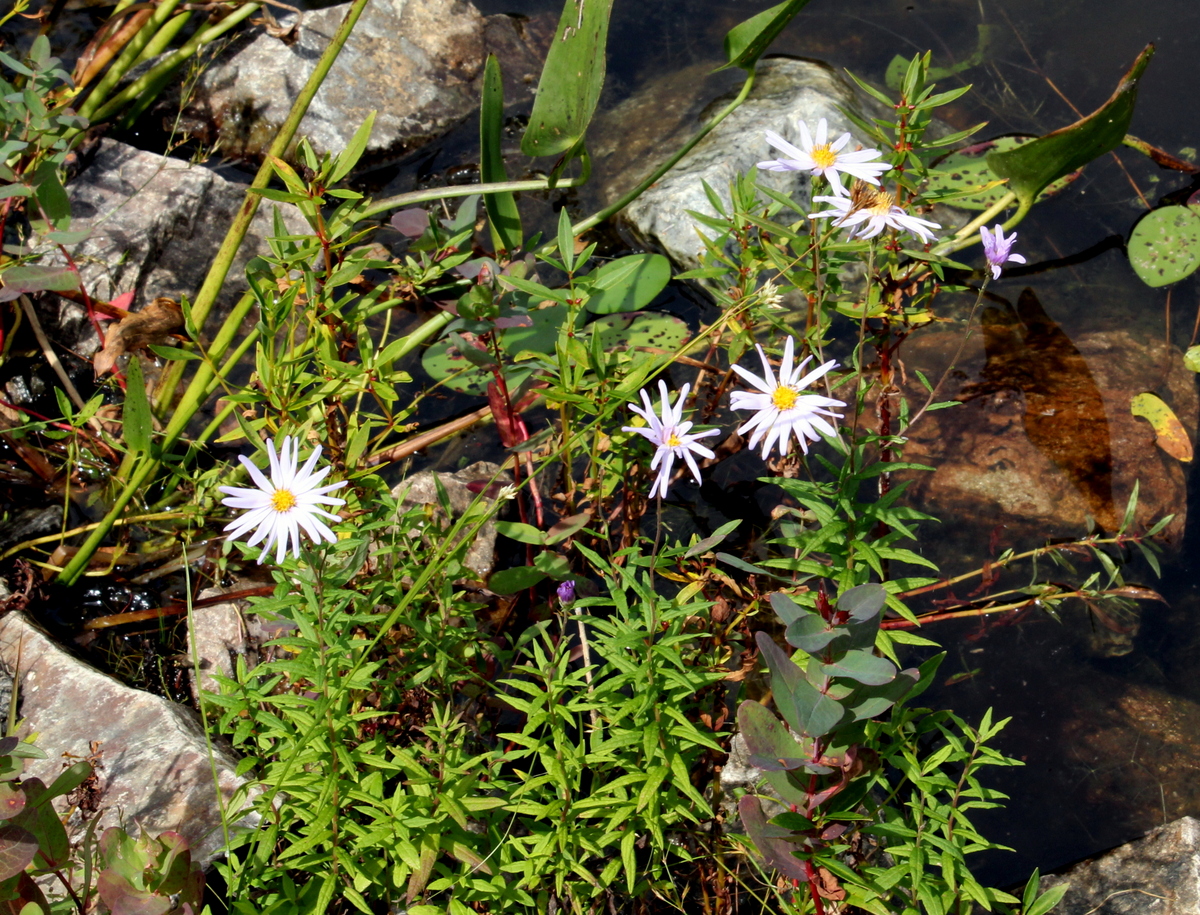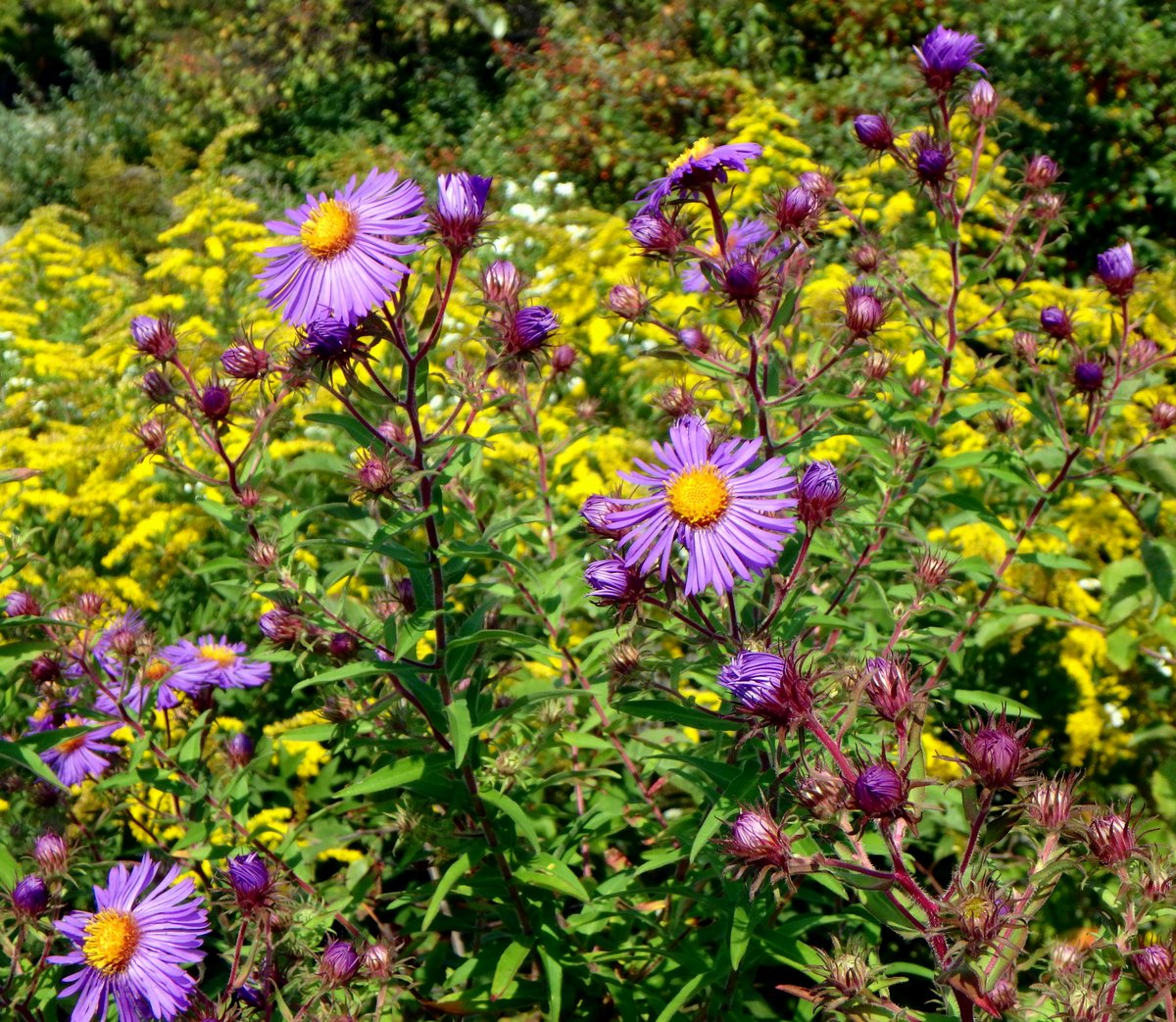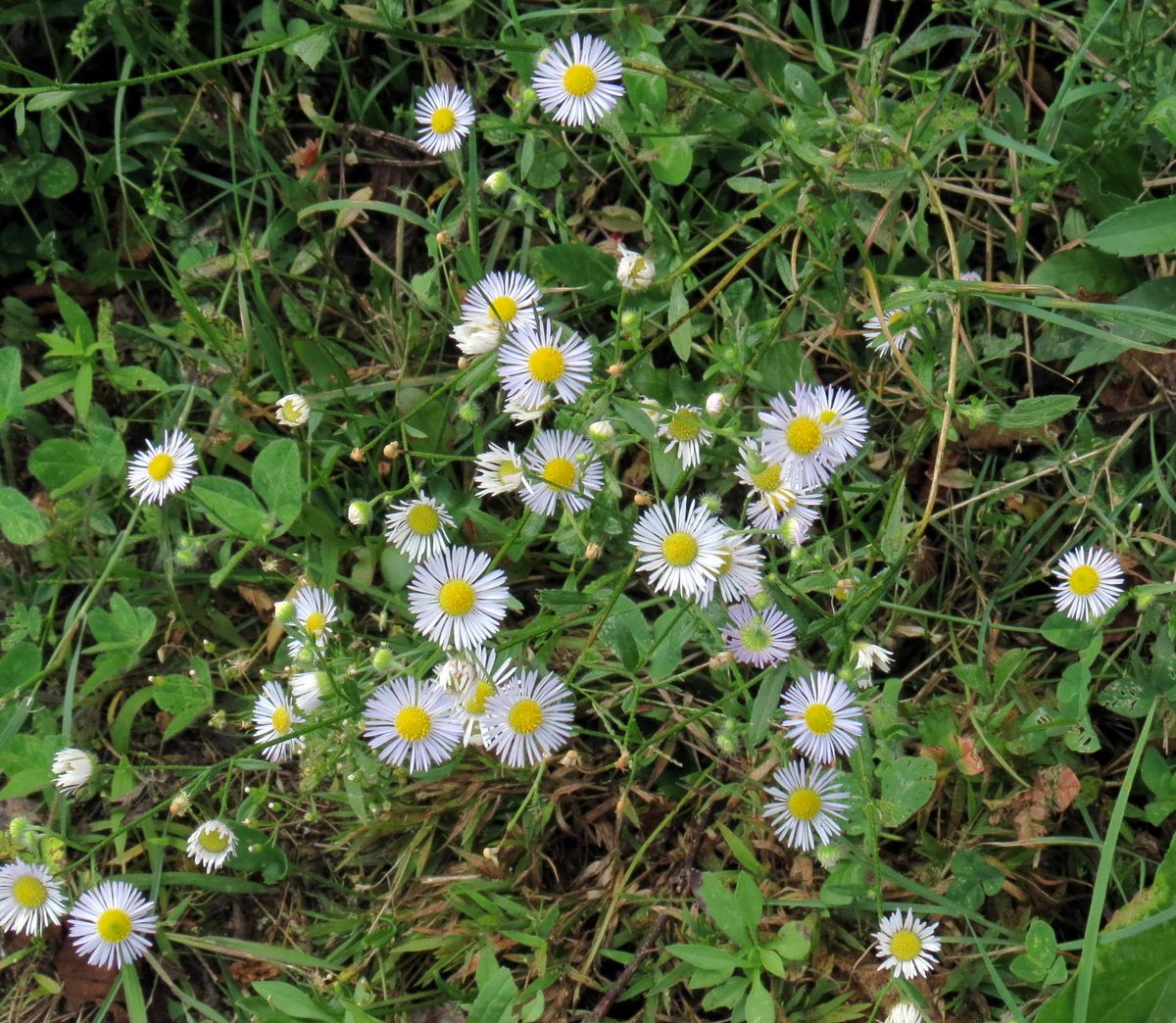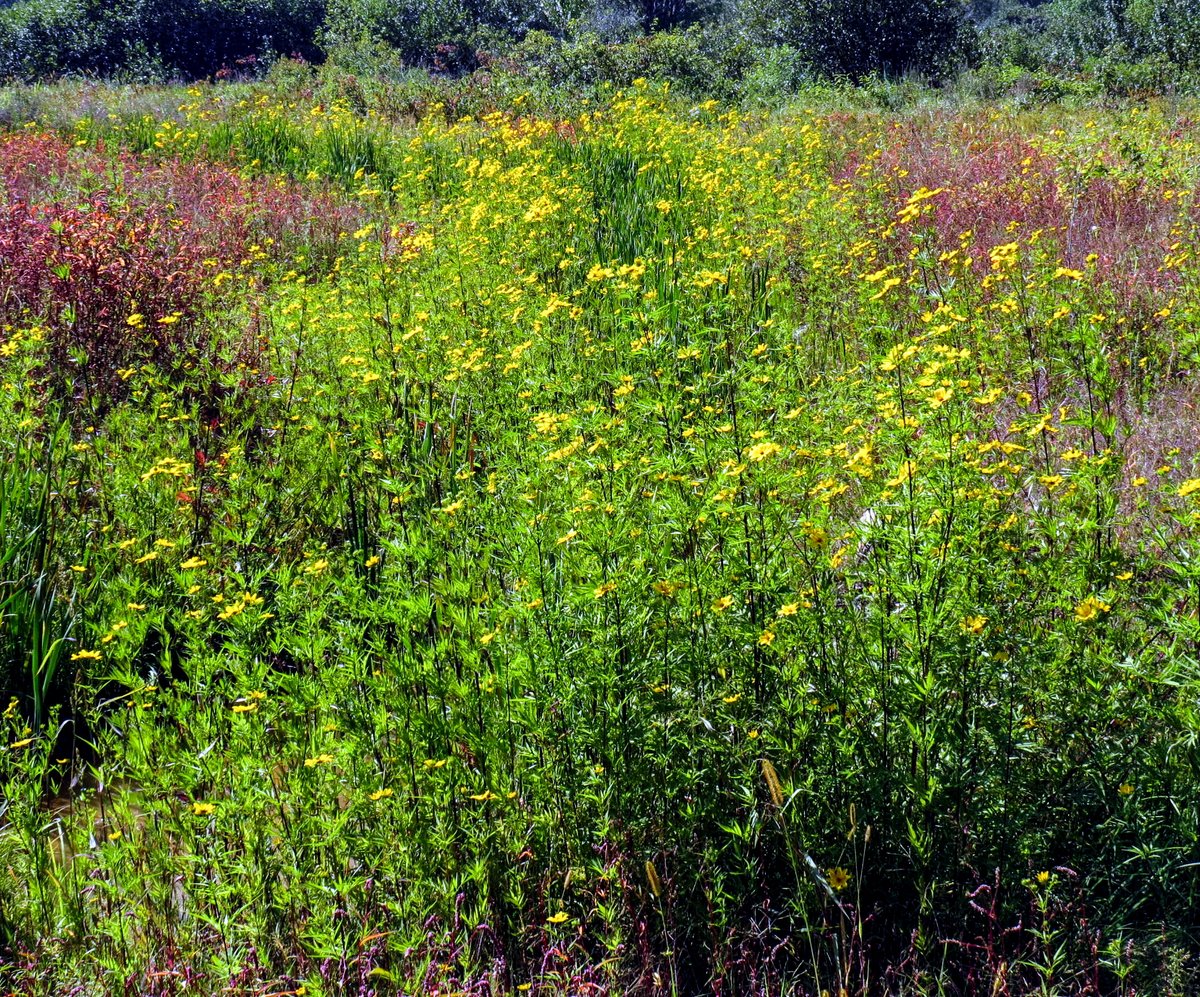
We are in full on, everywhere you look aster time here in this corner of New Hampshire, and that includes my favorite deep purple New England aster (Symphyotrichum novae-angliae.) You have to search for this color because they aren’t anywhere near as common as the lighter lavender asters. In this particular spot these plants have lots of competition so they can get quite tall. I saw plants on this day that were taller than I was.

The flowers were beautiful and so was the place they grew in. Now part of the local university system, this path winds through woods I played in as a boy. Now it’s part of a nature preserve and that makes me very happy, because its beauty should be preserved. The Ashuelot River is just over on the other side of that fence on the left and on this day, it was scary high. I saw evidence in places where it had topped its banks and flooded the forest so it’s probably best not to come here after heavy rains. But it’s such a beautiful spot I’ve decided that I should visit more often. I’m very anxious to come here when the leaves have colored up. These trees are almost all red and silver maples.

There were mixtures of asters and goldenrods in sunnier spots. I also found lots of Japanese knotweed out here, unfortunately.

There were fields of goldenrod too. Interestingly (unless you’re a photographer) not one of the three cameras I carried could cope with this scene. I took photos with all three and they were all baffled. So though it isn’t a good photo, it does give you an idea of what I saw here. It was just beautiful.

I like the contrast between goldenrod and those dark New England asters.

Most of the woodland sunflowers (Helianthus divaricatus) I saw had been flattened by the flooding but this one still stood tall. This is another native that can get quite tall. I sometimes see it growing up out of the middle of dogwoods and other shrubs.

There were two monarch butterflies on this stand of asters but of course they flew off as soon as I got close enough for a shot. But then this one couldn’t resist and came back for another taste.

I saw pure white New England asters too. They are not something I often see. In fact I think I’ve only seen them two or three times in the 10+ years I’ve been doing this blog.

This New England aster was in a sunny spot in the forest. This color is by far the most common but that fact does nothing to diminish its beauty.

I was out here a day or two earlier and saw even more monarchs. Unfortunately they were on some very invasive purple loosestrife.

But they were beautiful and yes, so was the purple loosestrife.

One more shot of this beautiful place that I have loved all of my life. I hope you liked seeing it too. What fun I had here when I was just a pup, but of course there were no mowed paths here then. Just the forest, but that was always enough.

I left one place I spent a lot of time in as a boy and went to another one and there, along the Ashuelot River near downtown Keene, I found more closed gentians (Gentiana clausa) blooming than I have ever seen before. Yes, these plants grow along this trail but these were not the ones I came to see. These were new to this place; previously unseen, and they made me wonder how they got here and how I could have missed them last year. They are not flowers you pass by with a nod and a shrug, because they’re rarely seen in this area, so I would have fallen onto my knees to admire them last year just as I did on this day.

But a minute or two after I fell onto my knees none of what I had just thought mattered, because I was lost in their unique beauty. It is a special kind of unusual beauty that makes me wonder if I were a bee, how would I get in there? And the leaves; why had they changed so soon? Though I know that fall starts on the forest floor I wondered if I had been missing it just as I had missed the gentians. I’m going to have to pay closer attention.

It’s turtlehead time. I haven’t seen any of our native white flowered plants this year so I’m guessing they aren’t a huge fan of lots of rain. These pink ones don’t seem to mind however; it was raining when I took this photo and they were in good health.

I’ve never seen turtles when I looked at turtlehead blossoms but after looking at this shot for a while, if I called that little whiteish “tongue” the head and the rest of the flower the shell, I finally saw a turtle. Whether or not that’s what others see, I can’t say.

I always like to look inside a turtlehead blossom because each time I do I see something I haven’t seen, like the stripe that guides insects straight into the blossom. And when an insect lands on the landing pad “tongue” and follows that stripe the hairy anthers on either side will brush their pollen all over it, so it can then fly off and pollinate another flower. Miracles; all around us every day. Nature will reveal them to you, if you pay attention and look closely.

Though its flowers resemble those of boneset, which flowers at the same time, white snake root’s (Ageratina altissima) large heart shaped, toothed leaves look nothing like boneset leaves. This plant contains a toxic compound called trematol, which is passed from the plant to cows that graze on it and when humans drink the milk or eat the meat before too long, they start to show signs of what was once called “milk sickness.” In a week or less most who drank the tainted milk would die of heart or liver failure. Abraham Lincoln’s mother died from what is believed to have been milk sickness when he was just 9 years old. All parts of the plant are toxic to cattle, horses, sheep, and humans, but today’s farmers eradicate the plant from their pastures and mix the milk from many cows together, so milk sickness is now virtually unheard of. A Native American woman from the Shawnee tribe is credited with finally warning settlers about this plant and most likely saving thousands of lives. If you use boneset medicinally you should get to know this plant well so you don’t confuse the two.

I went to the one place I knew of to find pretty little sand jointweed (Polygonum articulatum) flowers and could find not a single plant, but luckily later on I found several plants growing in the sand of a road shoulder. This curious little plant gets its common name from the way it that grows in pure sand, and from its many jointed stems. It is an annual, which grows new from seed each year. They grow to only about knee high and though there are usually many flowers per stem they’re so small they can be hard to see.

How small are sand jointweed blossoms? This shot from 2016 shows that they’re about 1/8 of an inch across, or nearly the same size as Abraham Lincoln’s ear on a penny. You can see the curiously jointed stems that give the plant its common name in this shot as well.

I’ve not been able to find any red cardinal flowers this year. All of those I’ve found in the past grew on the very edge of the water, so with all the flooding they’ve been either flattened or washed away. But, for the first time I did find blue lobelia, also called blue cardinal flower (Lobelia siphilitica) in a garden bed at a local park, of all places. I talked to some ladies who were tidying up the beds and they told me the plants had been there for many years. Too long for anyone to know how they came to be there, but I think they were most likely planted years ago. This is a plant I’ve been hoping to find for a very long time so I was happy to see it.

I think it’s time to say goodbye to our native chicory plants (Cichorium intybus) for this season. That’s too bad, because its flowers are a shade of blue not often found outside of a garden.

I noticed that plant breeders have been working on globe amaranth plants while I wasn’t watching. These I found in a local garden were like beautiful little starbursts.

I thought I’d save the biggest surprise for last; a Forsythia blossom in September. Then I saw four more the next day. Though they are a spring bloomer over the years I’ve found a blossom or two even during a warm January one year. It’s always a surprise.
The wonder of the beautiful is its ability to surprise us. With swift sheer grace, it is like a divine breath that blows the heart open. ~ John O’Donohue
Thanks for coming by.























































































































































































